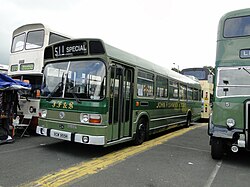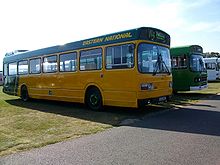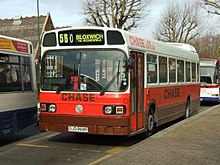Leyland National
| Leyland | |
|---|---|

single-door Leyland National in the long version |
|
| National | |
| Manufacturer | Leyland Motors |
| design type | Public bus |
| Production period | 1971-1985 |
| axes | 2 |
| engine | Diesel engine in the rear |
| power | 119 kW |
| length | 10.3 or 11.3 m |
| width | 2.5 m |
| height | with roof extension 3.3 m |
| Perm. total weight | z. B. 8,800 kg |
| Previous model | AEC Swift , Bristol RE |
| successor | Leyland Lynx |
The Leyland National is a bus model from the British commercial vehicle manufacturer Leyland Motors . This type was produced in large numbers (over 7000) from 1971 to 1985. The National was created as a joint project by the British nationalized transport industry - the National Bus Company (NBC) and British Leyland . The bus was developed to replace the single-decker buses previously produced by Leyland - the AEC Swift , the Bristol RE , the Daimler Fleetline , the Daimler Roadliner and the Leyland Panther . The National is a self-supporting regular-service bus, in which, contrary to the practice up to then common in Great Britain, the chassis and body came from one manufacturer. In the case of integral buses, the design and manufacture of the frame and body could be optimized, resulting in a lighter vehicle and easier production. The Leyland Titan (B15) double-decker bus produced between 1978 and 1984 was derived from the National .
construction
The bus had a diesel engine in the rear . All parts of the body were optimized for simple production and easy interchangeability of the individual parts. Some operators, such as London Transport , bought two-door models, while most of the other bus operators used the UK-common version with only one front double door.
The bus was available in both 10.3 and 11.3 m lengths. The shorter version can be recognized by the narrower windows. Up until 1978, all buses had a characteristic attachment on the rear part of the roof that accommodated the heating system. The heated air was led into the interior of the passenger compartment at roof height. The attachment was initially the length of a compartment and gave the bus a more American look. From 1974 the essay was shortened. In 1978, a simplified model came onto the market with the 10351B / 1R . The interior was changed, the attachment for the heater was omitted, it was now in the underbody, the heated air was led under the seats into the passenger compartment. The reduced weight reduced operating costs, which benefited the sales of the National . London Country procured a large number of these buses, which were taken over by other operators after the breakup of London Country .
The National 2 was introduced in 1979. It differed from its predecessor in that it had a radiator at the front - which made it 30 cm longer - and the optional engines.
engine
The National of the series Mk I had the O.510 six-cylinder diesel engine from Leyland with 8.3 l displacement , which was arranged under the floor in the rear . The cylinder heads of this engine could not be removed. For all work on the valves, the camshaft therefore had to be removed and the pistons pulled out of the cylinders in order to gain access from the inside via the displacement. This cumbersome procedure made maintenance and repairs expensive. The engine also suffered from high fuel consumption and sooted heavily, especially when poorly maintained. Some companies therefore looked for a way out and converted to engines from other manufacturers on a trial basis. The engine of the 10351B / 1R was throttled in performance, which should reduce the heavy soot.
The National 2 initially got the Leyland O.680, later the L11 developed from this engine. The O.680 was then no longer offered.
The operator Eastern Counties had installed the Gardner 6HLXB on a trial basis in several vehicles involved in the accident . This six-cylinder diesel engine had proven itself and gradually some National were converted to this engine. Gardner sued Leyland for not offering the engine as an option. As a result, from 1982 Leyland offered the 6HLXB and later the 6HLXCT as an option for original equipment.
commitment
The bus quickly became a familiar sight on British roads. In addition to the subsidiaries of the National Bus Company , the subsidiaries of the Scottish Transport Group , London Transport , SELNEC , Greater Manchester Transport , British Airways and other companies also procured the bus.
After a few years of use of the buses and as a result of the Transport Act 1980 and 1985 , which led to the deregulation of first cross-border and then inner-city bus traffic, the companies modernized the existing buses. Often DAF or Volvo engines were installed. The modular structure made repairs and modernization easier, and a bus could often be brought back into service within 24 hours.
The East Lancashire Coach Builders (East Lancs) developed with the Greenway a modernization possibility, but except frame and axles all other parts were replaced on.
export
Buses intended for export were also offered with a length of 10.3 m or 11.3 m. There were also a number of so-called hybrids with a length of 10.9 m. These buses had the wide windows of the long version up to the rear axle, and behind them the narrow windows of the short buses.
Latin America and the Caribbean
The construction could easily be converted to left-hand drive buses, so that a significant number of orders were received from mainland Europe and other countries with right-hand traffic. Nevertheless, the National was not particularly successful in the export markets. The largest order of 450 buses went to Caracas in 1975/76 . About 125 buses were from 1972 to 1974 by Kingston to Jamaica Omnibus Services delivered, a subsidiary of British Electric Traction company , 40 more buses to Trinidad and Tobago for the local National Bus Company .
Continental Europe
Some buses were sold to the Netherlands . There, after a short time, the windshields were exchanged for the version of multi-part flat panes that is common there to avoid reflections from the interior. A few buses also went to Oslo and Dijon .
Australia
In Canberra , ACTION buses operated a fleet of seventy National , all delivered between November 1974 and October 1975. Sixteen buses were completely delivered from England, 54 completed in Australia. The last ones were decommissioned in the early 1990s. Seven buses were procured by the Brisbane City Council's transportation division . Delivered in 1975, they were retired in 1985. The Melbourne and Metropolitan Tramways Board also procured ten buses in 1975.
The Metropolitan Transport Trust (MTT) (now Metro Tasmania ) in Tasmania procured a total of 63 National for use in the capital Hobart between 1975 and 1976 . This was exclusively the short version with a length of 10.3 m, but one bus was rejected by the customer and replaced by a hybrid.
Segregation
In total, over 7,000 were produced nationally . The bus model was superseded by the Leyland Lynx , but 1060 National were still produced after production began . The last major operator to use these buses was Chase Bus Services from Chasetown in Staffordshire , which ceased operations in April 2007. Some National s are still in use by smaller operators, but only two National s with the O.510 engine have survived . The production facility in Workington is now closed and serves as a depot for the logistics company Stobart Group .
Rail buses
Components of the National were in the railcar of Pacer class and the class 155 of the British Rail used. However, the front of was National against all expectations for use as a rail vehicle not suitable, as the experience with the LEV-1 called prototypes of Pacer showed and had to be replaced by a new structure. The body of the car was similar to the body of the bus, the equipment was identical but was arranged differently.
articulated bus
With parts of the National , the Danish subsidiary Leyland-DAB in Aabenraa developed an articulated bus with an underfloor engine in the front end, which was given a higher floor than the two-axle National with a rear engine.
Individual evidence
- ↑ Enthusiast's guide to Brisbane Transport buses - Fleet lists . Archived from the original on March 3, 2016. Info: The archive link was inserted automatically and has not yet been checked. Please check the original and archive link according to the instructions and then remove this notice. Retrieved March 4, 2009.
- ↑ Lynas, Ian N .: Buses and trams of Australia's government and municipal operators . Burwood Press, 1983, ISBN 0959258000 .





